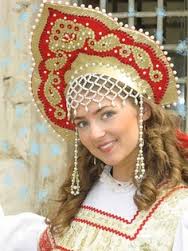
Kokoshnik is a headdress, a part of a woman's gown, which is put on the front of the head and serves protecting the hair. It became traditional for women to wear starting approximately from the middle of the XVI century, times of Ivan the Terrible. However the first kokoshniks, which derives from the word kokosh (hen) were found in Nizniy Novgorod in 11-12 centuries.
The woman who weared a kokoshnik was considered married. There are multiple variants of dresses which include kokoshnik as well as plentiful varieties of occasions it is weared.
There are different forms and colors of kokoshniks depending on the area, region, province or republic. Kokoshnik is painted on the front of the nesting doll, symbolising the strength of Russian woman's marital ties. It is also a purely Russian head outfit which is described in Russian folktales as well as by Russian famous poets, like Alexander Pushkin.